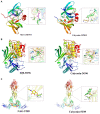Therapeutic targets and molecular mechanism of calycosin for the treatment of cerebral ischemia/reperfusion injury
- PMID: 34176787
- PMCID: PMC8266369
- DOI: 10.18632/aging.203219
Therapeutic targets and molecular mechanism of calycosin for the treatment of cerebral ischemia/reperfusion injury
Abstract
This study was designed to understand the pivotal anti-cerebral ischemia/reperfusion injury (CIRI) targets and pathways of calycosin through network pharmacology and molecular docking analyses. In this study, bioinformatics tools were employed to characterize and identify the pharmacological functions and mechanisms of calycosin for CIRI management. The network pharmacology data identified potential, merged CIRI-associated targets of calycosin including tumor protein p53 (TP53), protein kinase B (AKT1), vascular endothelial growth factor A (VEGFA), interleukin 6, tumor necrosis factor (TNF), and mitogen-activated protein kinase 1 (MAPK1). Molecular docking analysis indicated the binding efficacy of calycosin with three of the targets, namely TP53, AKT1, and VEGFA. The biological processes of calycosin for the treatment of CIRI are mainly involved in the improvement of endothelial cell proliferation and growth, inflammatory development, and cellular metabolism. In addition, the anti-CIRI actions of calycosin were primarily through suppression of the toll-like receptor, PI3K-AKT, TNF, MAPK, and VEGF signaling pathways. Taken together, the current bioinformatic findings revealed pivotal targets, biological functions, and pharmacological mechanisms of calycosin for the treatment of CIRI. In conclusion, calycosin, a functional phytoestrogen, can be potentially used for the treatment of CIRI in future clinical trials.
Keywords: bioinformatics; biotargets; calycosin; cerebral ischemia/reperfusion injury; network pharmacology.
Conflict of interest statement
Figures






Similar articles
-
Shenqi granules enhance recovery from cerebral ischemia-reperfusion injury by modulating tryptophan and tyrosine metabolism and activating NFE2L2/NRF2.Phytomedicine. 2025 May;140:156623. doi: 10.1016/j.phymed.2025.156623. Epub 2025 Mar 10. Phytomedicine. 2025. PMID: 40068292
-
A network pharmacology approach to decipher the total flavonoid extract of Dracocephalum Moldavica L. in the treatment of cerebral ischemia- reperfusion injury.PLoS One. 2023 Jul 26;18(7):e0289118. doi: 10.1371/journal.pone.0289118. eCollection 2023. PLoS One. 2023. PMID: 37494353 Free PMC article.
-
Neuroprotective Mechanisms of Calycosin Against Focal Cerebral Ischemia and Reperfusion Injury in Rats.Cell Physiol Biochem. 2018;45(2):537-546. doi: 10.1159/000487031. Epub 2018 Jan 25. Cell Physiol Biochem. 2018. PMID: 29402799
-
Nose to brain drug delivery - A promising strategy for active components from herbal medicine for treating cerebral ischemia reperfusion.Pharmacol Res. 2020 Sep;159:104795. doi: 10.1016/j.phrs.2020.104795. Epub 2020 Apr 8. Pharmacol Res. 2020. PMID: 32278035 Review.
-
Pharmacological therapy to cerebral ischemia-reperfusion injury: Focus on saponins.Biomed Pharmacother. 2022 Nov;155:113696. doi: 10.1016/j.biopha.2022.113696. Epub 2022 Sep 16. Biomed Pharmacother. 2022. PMID: 36116247 Review.
Cited by
-
Alteration of m6A epitranscriptomic tagging of ribonucleic acids after spinal cord injury in mice.Front Neurosci. 2022 Aug 25;16:904573. doi: 10.3389/fnins.2022.904573. eCollection 2022. Front Neurosci. 2022. PMID: 36090276 Free PMC article.
-
Targeting the neurovascular unit: Therapeutic potential of traditional Chinese medicine for the treatment of stroke.Heliyon. 2024 Sep 20;10(19):e38200. doi: 10.1016/j.heliyon.2024.e38200. eCollection 2024 Oct 15. Heliyon. 2024. PMID: 39386825 Free PMC article. Review.
-
Neuropharmacological effects of calycosin: a translational review of molecular mechanisms and therapeutic applications.Naunyn Schmiedebergs Arch Pharmacol. 2025 Apr 16. doi: 10.1007/s00210-025-04154-3. Online ahead of print. Naunyn Schmiedebergs Arch Pharmacol. 2025. PMID: 40237798 Review.
-
Exploring anti-liver cancer targets and mechanisms of oxyresveratrol: in silico and verified findings.Bioengineered. 2021 Dec;12(2):9939-9948. doi: 10.1080/21655979.2021.1985328. Bioengineered. 2021. PMID: 34592904 Free PMC article.
-
Bioinformatics approach and experimental validation reveal the hepatoprotective effect of pachyman against acetaminophen-associated liver injury.Aging (Albany NY). 2023 Sep 6;15(17):8800-8811. doi: 10.18632/aging.205000. Epub 2023 Sep 6. Aging (Albany NY). 2023. PMID: 37679038 Free PMC article.
References
Publication types
MeSH terms
Substances
LinkOut - more resources
Full Text Sources
Research Materials
Miscellaneous

